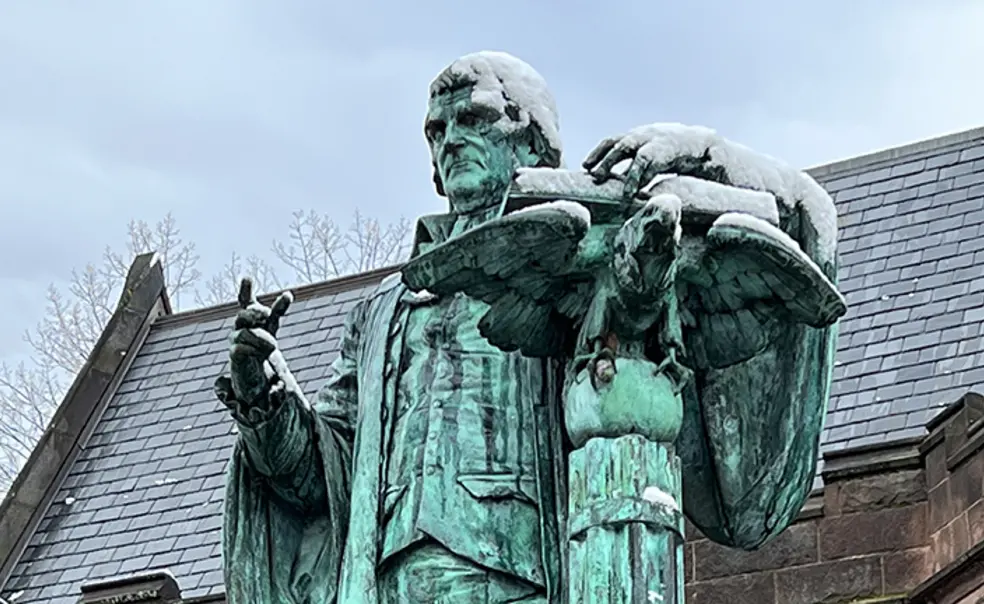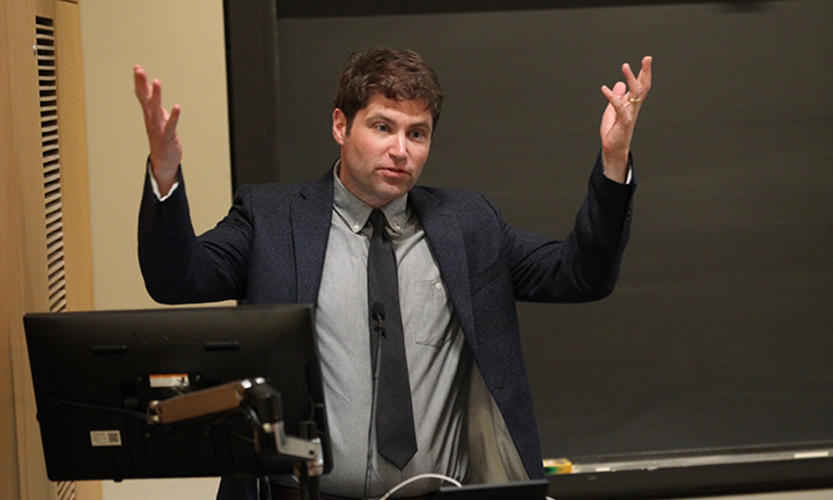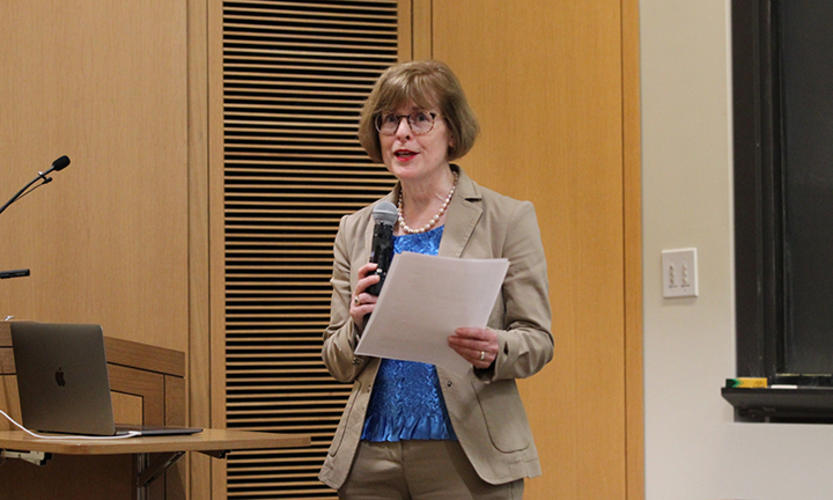Scholars Debate John Witherspoon’s Contradictions on Slavery
‘In short, it’s complicated. Witherspoon is complicated,’ said Rev. Gordon Mikoski
Why did founding father John Witherspoon voluntarily help Black people by tutoring them and offering religious services while owning slaves and declining to advocate for immediate abolition?
Historical documents have not given clear answers to that question or many others raised in a four-and-a-half-hour academic panel on April 21, organized by Princeton’s Committee on Naming. The committee is examining Witherspoon’s life and his stance on slavery as it considers a proposal to replace or remove a campus statue of Princeton’s sixth president.
Seven scholars, ranging from Princeton faculty to members of theological seminaries, presented different aspects of Witherspoon’s life and the period in which he lived. The panelists answered questions from an audience that grew to about 40 people. Angela Creager, interim chair of the Committee on Naming and chair and a professor of history at Princeton, moderated the discussion and said there will also be a panel on statues, memory, and commemoration this fall.
Witherspoon, who served as Princeton’s president from 1768 until his death in 1794, is the only clergyman and college president to sign the Declaration of Independence. He also signed the Articles of Confederation and was a delegate to the Second Continental Congress.
In 2001, a statue of him created by Scottish sculptor Alexander Stoddart was installed in front of East Pyne Hall. The naming committee held a series of listening sessions about the statue last fall after five members of Princeton’s philosophy department started a petition — which was eventually signed by 285 University community members — to replace the statue, as they felt it “pays great honor … to someone who participated actively in the enslavement of human beings, and used his scholarly gifts to defend the practice.”
The panel kicked off with remarks by Peter Wirzbicki, an assistant professor of history at Princeton, who focused on Witherspoon’s role in bringing Scottish common sense philosophy — which Wirzbicki said emphasized empathy — to the United States from Witherspoon’s native Scotland. Wirzbicki also acknowledged that despite Witherspoon’s long list of accolades, scholarship has only recently focused on his connections to slavery.The Rev. Kevin DeYoung, who wrote his dissertation on Witherspoon and is now an associate professor at the Reformed Theological Seminary in Charlotte, North Carolina, presented new evidence that Witherspoon may have received one or two slaves as part of his second marriage in 1791, and that until his death three years later, they were likely “treated as free Blacks in their own household, and at most, were to be kept in some type of servitude until age 28.”
Though DeYoung cautioned his conclusion is just a theory, he pointed to the discrepancy between Witherspoon’s will and the tax ratables for the year of his death, which both indicate that he had no slaves, and an appraisal of his property, which listed two slaves worth 200 pounds each “until they are 28 years of age.” That’s the same age that children of slaves in Pennsylvania were to be freed per the Gradual Abolition Act, which passed in 1780; Ann Dill, Witherspoon’s second wife, was from Pennsylvania.
Tax records also show Witherspoon owned slaves during part of the 1780s, though the documents are incomplete and it’s not clear how he came to own those slaves — if he bought them or if they came with his then-new 500-acre estate, for example.
“There’s no record that he dealt in the buying and selling of slaves,” DeYoung said, or that Witherspoon “treated his slaves poorly.”
After DeYoung’s remarks, Emmanuel Bourbouhakis, an associate professor of classics at Princeton, spoke about how Witherspoon made the study of rhetoric a focus of the University’s curriculum, which helped cement Princeton as a leading school and incubator of talent. He referred to the statue as “a historical and moral mirror — a reminder of the sometimes troubling source of the esteem and privileges we are nevertheless all too happy to exploit for our own careers and social position.”
Next, Lesa Redmond ’17, who completed her senior thesis on the Witherspoon family’s ties to slavery in the United States and wrote his entry for the Princeton & Slavery Project, cited incomplete records as part of the reason we have so many questions about Witherspoon, such as the nature of the education he voluntarily gave to several Black people.
“John Witherspoon had a host of choices available to him … and we don’t really have a lot to lead us to a statement on why he made these choices,” said Redmond, who is now a Ph.D. candidate at Duke University. She urged that historians give Witherspoon the benefit of the doubt on the subject based on the meager documentation available.
Sean Wilentz, a professor of history at Princeton, pointed to a May 1790 report Witherspoon co-authored as a member of the New Jersey Legislature that for the first time declared that a law abolishing slavery would be valid, though the committee declined to act at the time as they felt the practice of slavery was naturally dying out. “Witherspoon was on the anti-slavery side. He declared slavery unjustifiable,” said Wilentz.
Tera Hunter, a professor of history and of African American studies at Princeton, provided background about slavery during the period of Witherspoon’s life and reminded the audience to “consider the victims” who were subject to violence, cultural authority, and psychological tactics. “A key question that I would pose is that we ask ourselves, to what extent do we value the perspectives, the voices, of African Americans?”
The last speaker of the day, the Rev. Gordon Mikoski, an associate professor at Princeton Theological Seminary, presented on Witherspoon’s theological impact and Presbyterians’ thinking on slavery at the time. But again, Mikoski said there are no easy answers.“He was both a great man of conviction and courage, and a hypocrite and self-interested,” said Mikoski. “In short, it’s complicated. Witherspoon is complicated.”
Mikoski finished his remarks with a comment that as a Presbyterian, Witherspoon, as well as any other “self-respecting clergyperson” would not support the statue, as it breaks the second commandment, earning a chuckle from the audience.
“The University has a trust within its community and the public at large on something like this to get it right,” said Bill Hewitt ’74, who handed out printed copies of his own Witherspoon article recently published by The Tory and a Princetonians for Free Speech editorial challenging the Princeton & Slavery Project’s Witherspoon essay at the event. “This is good advocacy back and forth, and we sharpened one another, and others will be the judge.”
The Committee on Naming, a standing committee of the Council of the Princeton University Community (CPUC), provides advice on naming and iconography to the Board of Trustees. Creager told PAW that a recommendation could be made by next spring but was reluctant to set a timetable because she will be leaving her committee role in July. The ultimate decision will be made by the trustees.
“This is an opportunity for us to show what we do at Princeton, to engage knowledge in addressing difficult questions, and that’s going to be a slow process,” Creager said at the May meeting of the CPUC.
Examining Witherspoon’s Legacy
PAW spoke with Angela Creager, interim chair of the University’s Committee on Naming, about the Witherspoon statue petition. Below are condensed excerpts from that conversation.
About the process
“After we decided to take up the petition, we held listening sessions, and we found genuine divergence of opinion about the statue and the legacy of John Witherspoon. We then decided to set up two panels of scholarly experts: the first to take up historical specifics about Witherspoon, and the second to address the genre of statues and commemoration.
“The April symposium gave us a nuanced understanding of Witherspoon. On display was brand new scholarship. For me, the two questions Lesa Redmond ’17 raised remain absolutely central. One is how Witherspoon’s beliefs led him to recognize the intelligence of Africans and African Americans, because that’s not true of all white colonists in this time period. Her other question is, why did Witherspoon advocate for immediate emancipation for the colonists from Great Britain, yet gradual abolition for slaves? These questions point to the complexities of Witherspoon.”Principles for iconography
“The guidelines [approved by the trustees in 2021] focus on historical situation — whether someone was typical of their time or not — but there are also considerations about how the person’s legacy relates to the mission of the University. There is also a sensitivity that iconography can convey expectations and values about the institution that do not reflect what Princeton is and aspires to be, so that’s why the committee needs to think about what the statue does and doesn’t do to articulate and inspire the ideals of inclusivity that are very much a part of our community.”
On history’s ambiguity
“The history is complex — it’s really complex. People are going to have different interpretations, and that’s the way good history operates. That’s not a failing, that’s scholarship. People end up in really different places with respect to evaluating Witherspoon’s legacy, because the history itself is really complicated, making it hard to support an easy judgment. I think a lot of history is like that. We shouldn’t expect history to provide figures we can either celebrate or condemn without qualification. This is an interesting test case for thinking about how ambiguous history actually is and how complicated people are.”















5 Responses
Edmund C. Tiryakian ’78
2 Years AgoRelevant Distinctions in Witherspoon Discussion
I was dismayed by the letter of Ricshawn A. Roane ’96 (Inbox, July/August issue) seemingly dismissing efforts by the Rev. Kevin DeYoung to differentiate President John Witherspoon’s treatment of his slaves or the manner in which he acquired them as “irrelevant” and “an oxymoron.” To the contrary, the determining factor in whether Witherspoon’s statuary should be removed from campus because of his ownership of slaves at a time when slavery was legal in every colony should be whether Witherspoon mistreated his slaves outside the bounds of contemporary accepted standards. One cannot impose 21st-century mores upon those living within the accepted norms of the 18th century without engaging in an ex post facto rewriting of American history.
Wayne S. Moss ’74
2 Years AgoWitherspoon and Slavery
What a luxury to criticize John Witherspoon for owning slaves from the safety of 230 years later. Let’s look at the man in the context of his own time. He stood for freedom and had the courage to put his life on the line by signing the Declaration of Independence. Who among us has that kind of courage today? The fact that he owned slaves at a time when slave ownership was common, acceptable, and legal does not diminish from his promotion of an institution (Princeton) that today endorses universal human rights for all. Nor did his slave ownership prevent his furtherance of a nation that on at least some occasions has actually stood for life, liberty, and the pursuit of happiness for all.
Let him who is without sin cast the first stone. And let Witherspoon’s statue stay where it is. The only other place that could possibly be acceptable is in front of Nassau Hall, the place where he helped to mold the first generation of national leaders.
John F. Fay *85
2 Years AgoHow Would Witherspoon View Us?
Regarding the Committee on Naming in general, and the controversy over John Witherspoon in particular, I would like to suggest that before sitting in judgment on our ancestors we should allow them to sit in judgment on us. Fair is fair, after all, and barring serious moral consideration it is only an historical conceit that would lead us to believe that our views are any more valid than theirs.
With this in mind, how would John Witherspoon and his cohort regard our present society? We have demonstrated our inability to build successful marriages; we have aborted a quarter of our rising generation; and now we are showing ourselves unable to define exactly what it is that makes a person male or female. I have a fair idea that his judgment of us would be quite harsh; speaking objectively, I doubt that we have the moral standing to pass judgment on Witherspoon and his times. We should leave that for a more capable generation.
Ricshawn Adkins Roane ’96 s’94
2 Years AgoAll Slavery Is Poor Treatment
Reading about the academic panel organized by Princeton’s Committee on Naming, which is examining President John Witherspoon’s life and his stance on slavery as it considers a proposal to replace or remove a campus statue in his likeness (On the Campus, June issue), I felt compelled to respond to a comment made by a panelist, the Rev. Kevin DeYoung. As evidence of Witherspoon’s character, DeYoung is quoted as saying, “There’s no record that he dealt in the buying and selling of slaves or that he treated his slaves poorly.”
So we are all clear, how one came to own humans as property is irrelevant to both the discussion and, more importantly, to the enslaved. Furthermore, not treating slaves poorly is an oxymoron. Ownership and authority over another person’s body is, by definition, poor treatment.
Bill Hewitt ’74
2 Years AgoKudos for PAW’s Coverage and Concerns on Withholding, Nonresponses
Thanks to the PAW for providing much needed coverage to the highly important – and timely – April 21 scholarly symposium “John Witherspoon in Historical Context.” This symposium provided important new information about Witherspoon’s relation to slavery. Additionally, I found the symposium an example of Princeton at its best in its earnest and forthright evaluation of certain controversial aspects of Witherspoon’s life and legacy.
Moreover, the entire video record of the Witherspoon symposium should be provided on the Princeton & Slavery Project’s website to accompany its video coverage of the 2017 symposium celebrating the commencement of the project. The University’s April 12 email announcing this symposium plainly stated that video of the symposium would be made available online for benefit of those who did not attend. Much to my concern, the University has instead decided to withhold these videos from the Princeton community. I have asked President Eisgruber to make these important videos promptly available to all who are interested in them.
I note further that the Princeton & Slavery Project, which describes itself as “an ongoing research project that will continue to grow, as users contribute new documents and additional research,” has not even acknowledged the important new information about Witherspoon’s relation to slavery published in January by Witherspoon scholar Kevin DeYoung (himself one of the presenters at the April 21 symposium). I am deeply troubled that the project refuses even to acknowledge manifest problems in its “John Witherspoon” essay and the public’s reliance on this faulty essay. Attempts to get these issues addressed still await any response. (I specifically refer the interested reader to the March 1, 2023, open letter to President Eisgruber by Princetonians for Free Speech and my own later open letter to the director of the Princeton & Slavery Project.)
The Princeton & Slavery Project instead proceeds like a ghost ship — the Flying Dutchman of Princeton. Its works are plainly seen, but repeated calls to the project all go unanswered. Far worse, it continues to haunt Princeton with what I believe is profound misinformation. Is there left on board even a single soul to guide this lost ship?